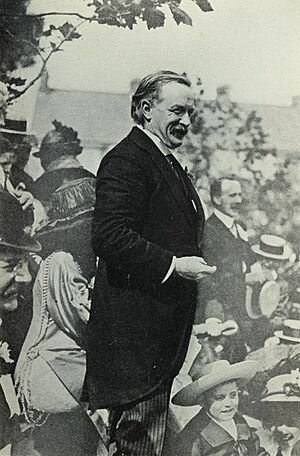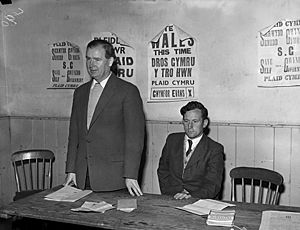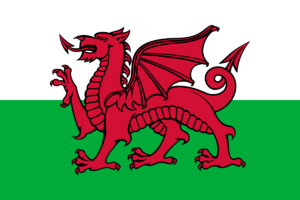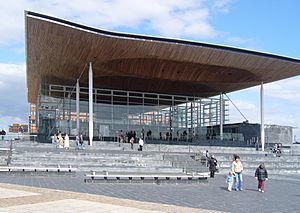Welsh nationalism facts for kids
Welsh nationalism (Welsh: Cenedlaetholdeb Cymreig) is all about celebrating what makes Wales special. It focuses on the unique Welsh culture and the idea of Wales as its own nation or country. Sometimes, Welsh nationalism also means wanting more power for Wales to make its own decisions. This could be through the Senedd (the Welsh Parliament) having more control, or even Wales becoming fully independent.
History of Wales
Early Welsh Kingdoms and English Rule
Before the English took over, Wales was made up of many different kingdoms. Sometimes, strong leaders like Hywel Dda, Gruffydd ap Llywelyn, and Rhodri the Great brought these kingdoms together. But after they died, the lands often split apart again.
For a short time, from 1055 to 1063, Wales was a single independent country. This was under Gruffydd ap Llywelyn, the only King of Wales to rule all Welsh lands. Soon after, the Normans invaded. They controlled much of Wales for a while. By 1100, their control was mostly in the lowlands. The border areas between Welsh princes and Norman lords became known as the Welsh Marches.
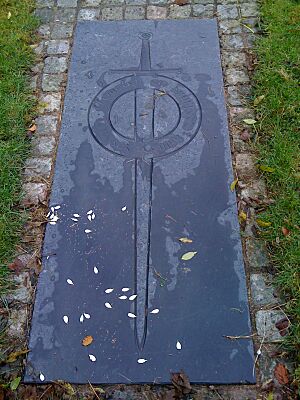
English and Norman attacks made the Welsh kingdoms fight among themselves even more. In the 12th century, King Henry II of England used these differences to gain power in Wales. He defeated and then allied with some Welsh rulers. This helped him take control of much of Wales by 1171.
In the 13th century, Llywelyn the Last was the final Prince of Wales. He made a deal with King Henry III in 1267 to keep his rights to Wales. But Henry's son, Edward I, didn't like Llywelyn's alliances. In 1276, Edward's army forced Llywelyn to give up most of his power. In 1282, Llywelyn was killed while trying to get support near Builth Wells. His brother, Dafydd ap Gruffydd, tried to lead the Welsh but was captured and executed. This ended Welsh independence.
Welsh Rebellions and New Beginnings
After the conquest, there were several Welsh rebellions against English rule. The biggest and last one was the Glyndŵr Rising from 1400 to 1415. This revolt briefly brought back Welsh independence. Owain Glyndŵr held the first Welsh parliament (Senedd) in Machynlleth in 1404. He was declared Prince of Wales there.
After Glyndŵr's rebellion was defeated, Wales lost its independence again. It wasn't until 1999 that a Welsh law-making body was set up again. This was the National Assembly of Wales, which became the "Senedd Cymru/Welsh Parliament" in 2020.
In the 16th century, King Henry VIII passed the Laws in Wales Acts. These laws fully joined Wales with the Kingdom of England. They were passed without any vote from the Welsh people. These laws removed the Welsh legal system and made Wales part of the English one. They also gave Wales representatives in the Westminster Parliament. However, the Welsh language lost its official status and role in Wales.
Changes in the 19th Century
The growth of factories and industries in parts of Wales, like Merthyr Tydfil, led to strong working-class movements. These included the Merthyr Rising in 1831 and support for Chartism.
Many Welsh people became Nonconformists, meaning they were Protestants who were not part of the Church of England. This led to more radical ideas. Ministers like David Rees and William Rees started radical magazines.
The Blue Books Report
In 1847, reports on education in Wales made many Welsh nationalists angry. These reports had blue covers and were called Brad y Llyfrau Gleision, or "The Treason of the Blue Books". They said that Welsh education was terrible. They also criticized the Welsh language and Nonconformist religion. The reports famously described Welsh speakers as "barbaric and immoral".
Cymru Fydd Movement
David Lloyd George was a key leader of Cymru Fydd. This group wanted a Welsh Government and a stronger Welsh identity. Lloyd George was seen as a radical figure. He was linked to the new interest in Welsh nationalism. In 1880, he said Wales should manage its own affairs. Historians see him as a pioneer for Welsh devolution. He also tried to create a separate Welsh National Party. However, the Cymru Fydd movement ended in 1896 due to disagreements.
Impact of Industrial Growth
Even with new patriotic movements, English influences remained strong in Wales. English was the only official language. More English people moved to Wales for work, and railways spread English culture. Many Welsh people stopped speaking Welsh. They thought English would help them succeed more. By 1911, Welsh was a minority language in Wales. Only 43.5% of people spoke it. Welsh nationalism became weaker as the coal industry in South Wales became more connected to English industry.
The 20th Century and Plaid Cymru
In the 1920s, the Labour Party became very strong in Welsh politics. Many Labour leaders in Wales, like Aneurin Bevan, believed nationalism was old-fashioned. They wanted a strong government in London to control the economy.
In 1925, Plaid Genedlaethol Cymru ("National Party of Wales") was founded. It was later renamed "Plaid Cymru - The Party of Wales" in 1945. The party's main goals are:
- Wales should govern itself.
- To protect Welsh culture, traditions, language, and economy.
- For an independent Wales to join the United Nations.
Gwynfor Evans was the first Plaid Cymru member to win a seat in the Westminster Parliament in 1966. By 1974, they had three Members of Parliament (MPs). In the 2019 election, they won four seats. When the Senedd was formed in 1999, Plaid Cymru won 17 out of 60 seats. In 2021, they won 13 seats.
In the 1950s, as the British Empire ended, people felt less "British." They also noticed that Wales was not as wealthy as other parts of the UK or smaller European countries. Some felt that Wales needed its own government to truly represent its people. The Tryweryn flooding, which almost all Welsh MPs voted against, made many feel that Wales had no power. The Epynt clearance in 1940 also showed how little control Wales had over its own land.
On July 1, 1955, a meeting was held to discuss a petition for a Welsh Parliament. Megan Lloyd George, daughter of David Lloyd George, was a main leader. She presented the petition with 250,000 signatures to the British government in April 1956.
Official Flag and Capital City
The first official flag of Wales was made in 1953 for Queen Elizabeth II's coronation. This flag, which included a royal badge, was criticized. In 1959, the Welsh flag was changed to the red Welsh dragon on a green and white background. This is the flag used today.
On December 21, 1955, Cardiff was announced as the official capital of Wales. This followed a vote by Welsh local authorities. Cardiff won because it was the largest city in Wales. It also had important buildings like City Hall and the National Museum of Wales. Dr Martin Johnes says that Cardiff truly became a capital when the devolved assembly was formed in 1999. It became the home of the Welsh government.
The 21st Century
A 2007 survey found that 20% of Welsh people wanted Wales to be independent from the United Kingdom. There have also been calls for a new UK flag that includes a symbol for Wales. Currently, Wales is the only UK nation not represented on the Union Jack.
In 2009, the Archbishop of Wales, Dr Barry Morgan, asked for the Welsh Assembly to have full law-making powers. He wanted Wales to have "greater self-determination."
Polls on Welsh independence have varied. A 2015 poll suggested 17% support, while another said it could be as high as 28%. Earlier polls had shown much lower support. After the 2016 Brexit vote, support for Welsh independence increased. A poll showed that 35% of those who had an opinion would vote for independence if Wales could stay in the European Union.
In 2022, Dafydd Iwan's 1983 song Yma o Hyd ("Still here") became an anthem for the Welsh World Cup football team. This song is a nationalist song, talking about events in Welsh history.
Major Active Parties and Movements
- YesCymru is a group that campaigns for an independent Wales. It started in 2014 and officially launched in 2016.
- Plaid Cymru - The Party of Wales was founded in 1925. Its goals are self-government for Wales, protecting Welsh culture and economy, and Wales joining the United Nations as an independent state.
- Cymdeithas yr Iaith Gymraeg (Welsh Language Society) started in 1962. It is a group that campaigns for Welsh language rights. They use peaceful direct action and see themselves as part of a global movement for change.
Militant Nationalism
Quick facts for kids Welsh nationalism |
|||||||
|---|---|---|---|---|---|---|---|
|
|||||||
| Belligerents | |||||||
|
Welsh militant groups
|
|
||||||
Most Welsh nationalism has been peaceful and focused on political change. However, there have been some groups that used more extreme methods.
- In 1952, a small group called Y Gweriniaethwyr ("The Republicans") tried to blow up a pipeline from the Claerwen dam to Birmingham. They were unsuccessful.
- In the 1960s, two groups formed to protest the flooding of the Tryweryn valley and the 1969 investiture of Charles, Prince of Wales. These were Mudiad Amddiffyn Cymru ("Movement for the Defence of Wales," also known as MAC) and the Free Wales Army (FWA). MAC carried out several bomb attacks on water and power lines in Wales. Two people believed to be MAC members died in 1969 when a bomb they were planting exploded.
- In the late 1970s and 1980s, a group called Meibion Glyndŵr ("sons of Glyndŵr") set fire to many holiday homes across Wales. They were protesting against these homes, which they felt were harming Welsh communities.
See also
In Wales
Similar Nationalist Movements
- Irish nationalism
- Irish republicanism
- Scottish independence
- Scottish nationalism
- Cornish nationalism
- Cornish self-government movement
- Breton nationalism
Celtic Movements
- Celtic Congress
- Celtic League (political organisation)
- Celts (modern)



